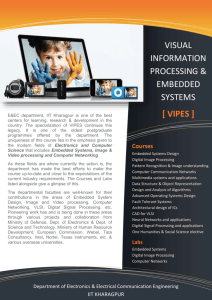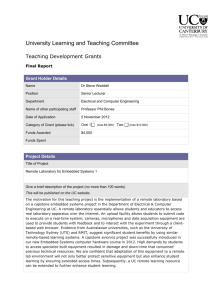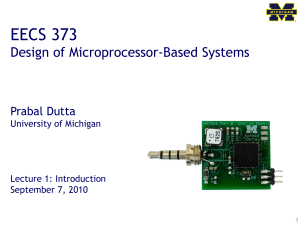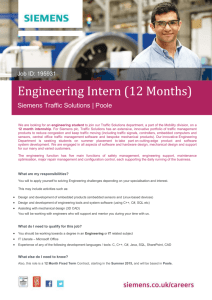Demo Summary - Chess - Center for Hybrid and Embedded
advertisement
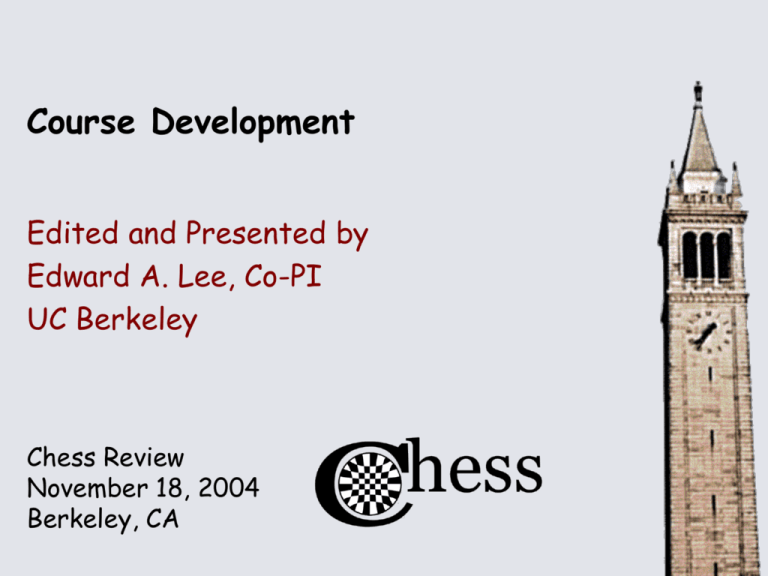
Course Development Edited and Presented by Edward A. Lee, Co-PI UC Berkeley Chess Review November 18, 2004 Berkeley, CA Recall the Goal To create a integrated computational systems theory and systems design practice with – – – – – – – – Concurrency Composability Time Hierarchy Heterogeneity Resource constraints Verifiability Understandability This systems theory must be at once computational and physical. Chess Review, November 18, 2004 2 The Problem (1) Models for the physical world and for computation diverge. – physical: time continuum, ODEs, dynamics – computational: a “procedural epistemology,” logic There is a huge cultural gap. Physical system models must be viewed as semantic frameworks, and theories of computation must be viewed as alternative ways of talking about dynamics. Chess Review, November 18, 2004 3 The Problem (2) Students are taught to use modeling techniques, not to evaluate modeling techniques. – “this is how computers work” – “this equation describes that feedback circuit” rather than – “this is how VonNeumann proposed that we control automatic machines” – “ignoring the intrinsic randomness and latency in this circuit, Black proposed that we could idealize its behavior in this way” Students must be taught meta-modeling, not just modeling. They must learn to think critically about modeling methods, not just about models. Chess Review, November 18, 2004 4 The Graduate Curriculum We have developed courses in: • Hybrid Systems • Embedded Software and Systems • Model Integrated Computing A key challenge is to define the durable intellectual heart of hybrid and embedded systems. Focus first on embedded software… Chess Review, November 18, 2004 5 A Tempting Incremental Approach to Teaching Embedded Software Orient courses around resource limitations: • small memory • small data word sizes • relatively slow clocks To deal with these problems: • write software at a low level (in assembly code or C) • teach microcomputer interfacing (DMA, interrupts) • teach how to use RTOSs (priorities, preemption) • discuss specialized computer architectures – programmable DSPs – network processors This is not what we are doing (mostly)! Chess Review, November 18, 2004 6 If Resource Limitations are the Key Defining Property of Embedded Systems, Why hasn’t Moore’s law changed all this in 25 years? Chess Review, November 18, 2004 7 Embedded Software Differs More Fundamentally from General Purpose SW Hints that this is true: • object-oriented techniques are rarely used – classes and inheritance – dynamic binding • processors avoid memory hierarchy – virtual memory – dynamically managed caches • memory management is avoided – allocation/de-allocation – garbage collection To be fair, there are some applications: e.g. Java in cell phones, but mainly providing the services akin to general purpose software. Chess Review, November 18, 2004 8 Fundamentally Different Techniques Are Being Applied to Embedded SW. • nesC/TinyOS method-call models of computation – developed for programming very small programmable sensor nodes called “motes” • Click – created to support the design of software-based network routers • Simulink with Real-Time Workshop actor-oriented models of computation – created for embedded control software and widely used in the automotive industry • Lustre/SCADE – created for safety-critical embedded software (e.g. avionics software) Chess Review, November 18, 2004 9 Graduate Embedded Software Classes at Berkeley • EECS 249 Design of Embedded Systems: Models, Validation, and Synthesis This course is about the design of embedded real-time systems. It presents the principles of a methodology that favors design re-use, formal verification, software design and optimized architecture selection. The basic tenet of the methodology is separation of function and architecture, computation and communication. This methodology called platform-based design is presented as a paradigm that incorporates these principles and spans the entire design process, from system-level specification to detailed circuit implementation. • EECS 290O Embedded Software Engineering Introduction to embedded software engineering: the first part covers real-time operating systems, real-time communication protocols, and scheduling theory; the second part focuses on real-time programming and code generation. Real-time communication protocols like the time-triggered protocol (TTP) and the event-triggered CAN protocol are discussed. Scheduling techniques like rate-monotonic and earliest deadline first are illustrated. The second half of the course emphasizes real-time programming and code generation for embedded systems focusing on the languages Esterel, Lustre, and Giotto. • EECS 290N Concurrent Models of Computation for Embedded Software This course is about the foundations of specification and modeling of concurrent real-time systems. The course combines an experimental approach with a study of formal semantics. The objective is to develop a deep understanding of the wealth of alternative approaches to managing concurrency and time in software. Complementary courses with slants towards practice & theory. Chess Review, November 18, 2004 10 EECS 249: Design of Embedded Systems: Models, Validation, and Synthesis Taught regularly at Berkeley, this project course introduces graduate students to modeling and design for embedded systems. Lectures: • Introduction • Platform-Based Design • Models of Computation • MoCs: FSMs, CFSMs • MoCs: KPN and Dataflow • The Tagged Signal Model • MoCs: Petri Nets • MoCs: Synchronous Languages • Heterogeneous Composition: Hybrid Systems • SystemC • Architecture Modeling • Microprocessors Modeling • Mapping of Function to Architecture • Software Estimation • Software Synthesis • Scheduling and RTOS • ….. Chess Review, November 18, 2004 11 EECS 290N: Concurrent Models of Computation for Embedded Software Taught at Berkeley experimentally under the heading of “Advanced Topics in Systems Theory,” this course is a starting point for a textbook and (we hope) a regular mainstream graduate class. Lectures: • Introduction • Current Trends in Embedded Software • Threads • Actor-Oriented Models of Computation • Process Networks • Extending Ptolemy II • Process Networks Semantics • Continuous Functions and PN Compositions • Execution of Process Networks • Introduction to Synchronous Languages • Synchronous Language Semantics • Discrete-Event Systems • Tags and Discrete Signals • Metric Space Semantics • Dataflow Process Networks • Generalized Firing Rules • The Cal Actor Language, • Statically Schedulable Dataflow • Extensions to SSDF • Boolean Dataflow • Scheduling Boolean Dataflow • … Chess Review, November 18, 2004 12 Outreach: Graduate Class in Civil and Environmental Engineering (CEE) CE 290I … teaches students models of computation in the context of a suite of civil engineering case studies. The idea is to approach a control or information management problem by first choosing an appropriate model of computation, then choosing an appropriate high-level embedded programming tool, and finally using the tool to create software that is transparent, explainable, or verifiable. Graduate students from structural engineering, construction, and transportation have taken the course, as have structural engineers from the NSF sponsored National Earthquake Engineering Simulation (NEES) program. Other students taking the class have been working on problems like deploying sensor networks to monitor the wind response of the Golden Gate Bridge, to measure seismic waves using down-hole sensor arrays, to control illumination in buildings, and to coordinate traffic signals for smoothing freeway traffic flow. The class has also drawn students from ME, EECS, and IEOR. Chess Review, November 18, 2004 13 EE290o: Model-Integrated Computing1. Adoption of the Vanderbilt course (see below) at Berkeley. This course teaches the purpose, design and implementation of domain-specific modeling environments through formal modeling and metamodeling. 1. Lectures: • Introduction • MIC Overview – Terms and Definitions • MIC Overview – Concepts • Language – Syntax and Semantics (2x) • Language Representation • Structural Modeling • Structural/Behavioral Modeling • Behavioral Modeling • Abstraction and Encoding (2x) • MGA Modeling Tool Suite & Resources • MGA Modeling Resources • Metamodeling • Metamodeling Example • Attaching and Defining Semantics • Interpreter Writing – Class Library • Interpreter Writing – Example • Designing DSMEs (3x) • Constraints • Real World MIC Examples • … Presented as a poster by Jonathan Sprinkle Chess Review, November 18, 2004 14 EECS 291E; Hybrid Systems • Graduate Class in Hybrid Systems at UCB (also taught by Koo at Vanderbilt) • Textbook “The Art of Hybrid Systems” Lygeros, Tomlin and Sastry, in preparation Topics: • Hybrid Systems Examples: automotive, aerospace, • Hybrid Systems Definition, Existence of Solutions, Zeno Behavior • Controller Design for Timed Automata • Bisimulations, Decidability, Computability issues • Controller Synthesis for Hybrid Systems • Simulation Tools, Verification Tools • Stochastic Hybrid Systems, Applications to Systems Biology, Networked Embedded Systems • Projects: applications, conceptual. • … http://www.eecs.berkeley.edu/~imitchel/EE291E/ Chess Review, November 18, 2004 15 Next Steps at Berkeley • Systematize the graduate curriculum in hybrid and embedded systems – Measure of success: Multiple faculty teaching the same course at different times. • Integrate more broadly with other College of Engineering Courses – Hybrid and embedded software systems have natural applications in mechanical engineering, civil and environmental engineering, and bioengineering. • Make hybrid and embedded systems a legitimate concentration, with its own prelim exam and graduate admissions category. – We have taken the first step: for 2005 admissions, it is an admissions category at Berkeley. Chess Review, November 18, 2004 16 Vanderbilt Graduate Curriculum • CS375 Discrete Event Systems: Supervisory Control and Diagnosis – • CS376 Foundations of Hybrid and Embedded Systems – • Modeling, analysis, and design of hybrid and embedded systems. Heterogeneous modeling and design of embedded systems using formal models of computation, modeling and simulation of hybrid systems, properties of hybrid systems, analysis methods based on abstractions, reachability, and verification of hybrid systems. CS388 Model Integrated Computing – • Algebraic structures, automata and formal language theory, process modeling with finite state automata, supervisory control theory, controllability and supervision, supervisory control under partial observation, modular and hierarchical supervisory control, supervisory control of real-time systems, fault diagnosis of discrete event systems, and modular diagnosis approaches. Model-Integrated Computing (MIC) addresses the problems of designing, creating, and evolving embedded systems by providing rich, domain-specific modeling environments including model analysis and model-based program synthesis tools. Students are required to give a class presentation and prepare a project. CS379 Topics in Embedded Software and Systems – Specification and composition of domain-specific modeling languages. Design methodologies for embedded systems. Platforms for embedded system design and implementation. Analysis of embedded systems. Chess Review, November 18, 2004 17 CS388 Model-Integrated Computing Taught regularly at Vanderbilt as a general introduction course for modeling languages, model analysis and model based code generation. Lectures: • Introduction • Design Approaches in Embedded Systems • Modeling language examples • Specification of DSMLs: Concreate Syntax, Abstract Syntax and Semantics • Metamodeling approaches and languages • Design of DSML-s for MoC-s: FSMs, HFSMs, and Dataflow • Model transformation and code generation • Writing model-based code generators using procedural languages • Modeling code generators using graph transformation • Projects Chess Review, November 18, 2004 18 Integrating Learning into Technology-Based Engineering Environments CAPE authoring technology (based on GME, same modeling infrastructure used for embedded system tools) plus eLMS content repository and delivery platform support collaborative development and use of adaptive web-based learning experiences. Now support integrating learning resources into embedded systems tools and using embedded system tools within adaptive courseware. eLMS supports integration with academic course management systems. CAPE interoperation Authors eLMS Repository Instructors interoperation Embedded System Tools integration •MathWorks •Ptolemy II •Metropolis •GME eLMS Delivery Platform Academic CMS integration interaction Learners •Blackboard •WebCT •Sakai •others (OKI) Chess Review, November 18, 2004 19 Undergraduate Curriculum at Berkeley • Introductory course (EECS 20n) is mature and established. • Department is hiring a lecturer to assume principal responsibility for this course. • The course is starting to appear in outreach institutions (Cal State Hayward, for example). • Next step is to develop the follow-up courses. Chess Review, November 18, 2004 20 Mature Introductory Course on Computational Signals and Systems Berkeley has a required sophomore course for EE and CS students that addresses mathematical modeling of signals and systems from a computational perspective. A web page shows a broad view of feedback, where the behavior is a fixed point solution to a set of equations. This view covers feedback control systems, discrete-event systems, and hybrid systems. The textbook Chess Review, November 18, 2004 21 Proposal for 12x courses in systems EECS 12x courses are designed to follow EECS 20: • control systems • communications Needs to be developed • embedded systems • optimization • signal processing • stochastic systems These can benefit from the hybrid physical/computational viewpoint. Chess Review, November 18, 2004 22 Proposed prerequisite structure corresponding graduate classes 221 228, 263 222, 223 121 122 123 ME 134 Hybrid & embedded systems Computer networks Feedback control 224 225 124 125 Digital comm. Media & DSP 226 126 Stoch. systems 227 127 OR 162 Optimiz ation 20 Chess Review, November 18, 2004 23 Vanderbilt Undergraduate Curriculum Development of an Embedded Systems concentration for EE, CS, CE, ME and CEE is in progress. Courses that have been developed and offered: • EECE276 Microcontrollers 2 (to be renamed to Embedded Systems) – This course is about the design and implementation of embedded systems. The course covers basics of concurrent and real-time programming, real-time languages, the basics of model-based design of systems using functional and object-oriented techniques. Students are expected to participate in a team projects that constructs a small embedded system application. • CS274 Modeling and Simulation – General theory of modeling and simulation of a variety of systems: physical processes, computer systems, biological systems, and manufacturing processes. Principles of discrete-event, continuous, and hybrid system modeling, simulation algorithms for the different modeling paradigms, methodologies for constructing models of a number of realistic systems, and analysis of system behavior. Computational issues in modeling and analysis of systems. Stochastic simulations. • EECE296 Electrical and Computer Engineering Design – Based on product specifications typically supplied by industrial sponsors, teams of students responsible for the formulation, execution, qualification, and documentation of a culminating systems engineering design. The application of knowledge acquired from earlier coursework, both within and outside the major area, along with realistic technical, managerial, and budgetary constraints using standard systems engineering methodologies and practices. Chess Review, November 18, 2004 24 Outreach Tennessee Technological University As part of the SIPHER Program, Profs. Ramaswamy and Mahmoud from TTU have developed a new course: CSC/ECE 4990 Modeling and Simulation of Embedded Systems Chess Review, November 18, 2004 25 Conclusion • We still have a lot of work to do… Chess Review, November 18, 2004 26


